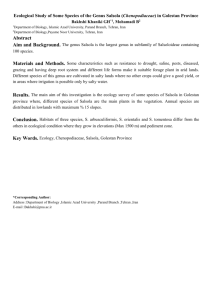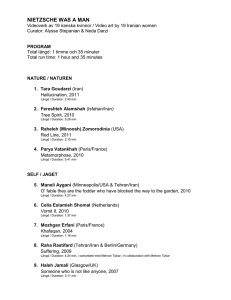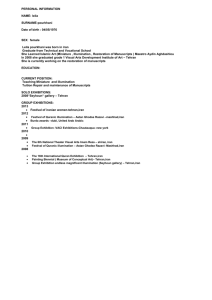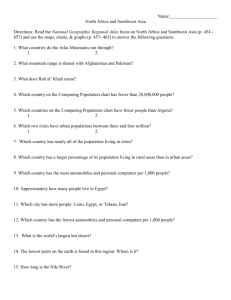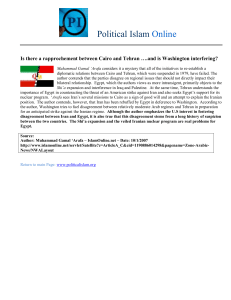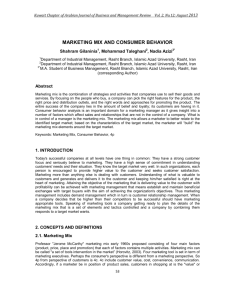ABS
advertisement
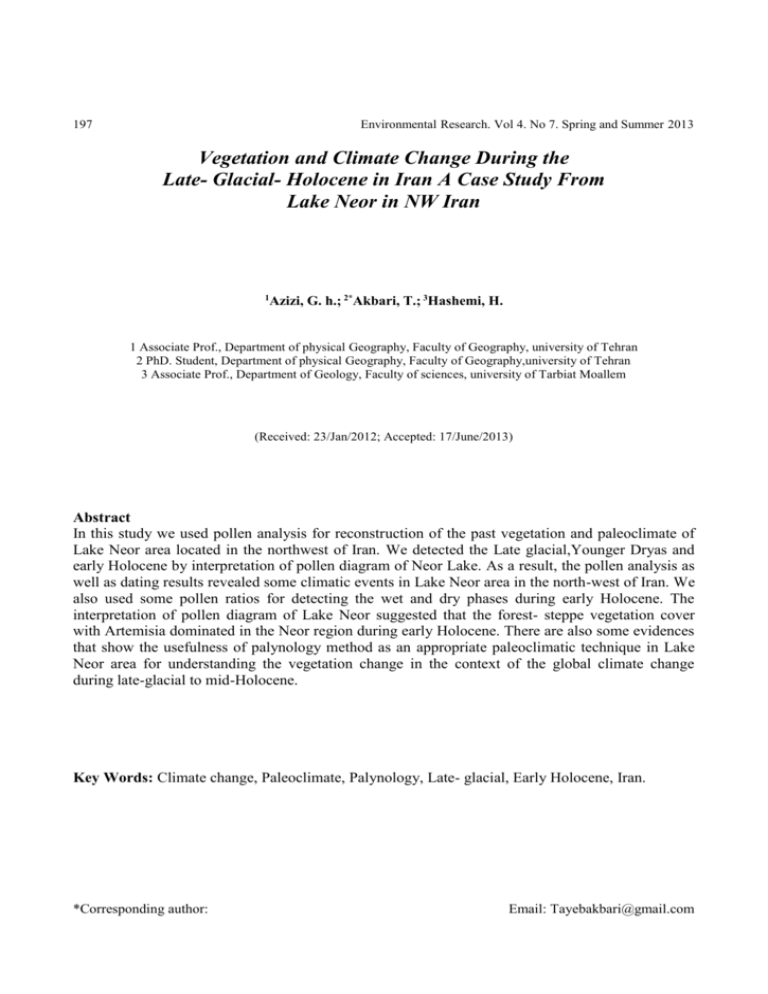
Environmental Research. Vol 4. No 7. Spring and Summer 2013 197 Vegetation and Climate Change During the Late- Glacial- Holocene in Iran A Case Study From Lake Neor in NW Iran 1 Azizi, G. h.; 2*Akbari, T.; 3Hashemi, H. 1 Associate Prof., Department of physical Geography, Faculty of Geography, university of Tehran 2 PhD. Student, Department of physical Geography, Faculty of Geography,university of Tehran 3 Associate Prof., Department of Geology, Faculty of sciences, university of Tarbiat Moallem (Received: 23/Jan/2012; Accepted: 17/June/2013) Abstract In this study we used pollen analysis for reconstruction of the past vegetation and paleoclimate of Lake Neor area located in the northwest of Iran. We detected the Late glacial,Younger Dryas and early Holocene by interpretation of pollen diagram of Neor Lake. As a result, the pollen analysis as well as dating results revealed some climatic events in Lake Neor area in the north-west of Iran. We also used some pollen ratios for detecting the wet and dry phases during early Holocene. The interpretation of pollen diagram of Lake Neor suggested that the forest- steppe vegetation cover with Artemisia dominated in the Neor region during early Holocene. There are also some evidences that show the usefulness of palynology method as an appropriate paleoclimatic technique in Lake Neor area for understanding the vegetation change in the context of the global climate change during late-glacial to mid-Holocene. Key Words: Climate change, Paleoclimate, Palynology, Late- glacial, Early Holocene, Iran. *Corresponding author: Email: Tayebakbari@gmail.com Abstracts 198 Wolf Subspecies Classifications Based on Mitochondrial Markers 1* Asadi Aghbolaghi, M.; 2Rezaei, H. R.; 3Zamani, V. 1 Master of Natural Resources– Environmental, Faculty of Natural Resources, University of Tehran, Karaj 2 Associate Professor, Department of Environmental Sciences, Gorgan University of Agricultural Sciences and Natural Resources, Gorgan, Iran. 3 PhD student, Genetic Conservation at Université Joseph Fourier, France (Received: 13/May/2012; Accepted: 17/June/2013) Abstract Population genetic structure of the population of wolves in the world and population fluctuations is dependent on glacial periods. The dispersal of wolves in Iran and the need to identify the exact species in conservation programs, in this study, relation of supspecies probable wolf in Iran, Canis lupus pallipes, (Canis lupus cubanensis and Canis lupus lupus) with other subspecies in the world genes based on full sequence of cytochrome b, control region genes of mtDNA, ND1 and CO1 gene in gene banks worldwide were recorded. Classification based on the sequences analysis of each gene was performed. And common haplotypet of the four genes mentioned above were determined and the haplotype network was drawn. Results showed that the subspecies Canis lupus lupus of the old haplotype with high dispersion in the Middle East and Europe has complex relationships with other subspecies in the world and also in ranking of wolf subspecies, control region and cytochrome b gene to CO1 and ND1 gene haplotype differentiate between them than superficially appear. Key words: Canis lupus lupus, MtDNA, Cytochrome b, Control region, ND1 gene, CO1 gene *Corresponding author: Email: marzyhasadi@yahoo.com Environmental Research. Vol 4. No 7. Spring and Summer 2013 199 Investigation of Effectiveness of EMS Establishment in Improvement of Environmental Performance of Industrial Units in Iran 1 Jamalzad Fallah, F.; 2 *Abedinzadeh, N.; 3Ravanbakhsh, M. 1 Academic Center for Education, Culture and Research ,Member of Educational Board of Environmental Research Institute of Jihad Daneshgahi 2 Academic Center for Education, Culture and Research, member of Educational Board of Environmental Research Institute of Jihad Daneshgahi Academic Center for Education, Culture and Research, Member of Educational Board of Environmental Research Institute of Jihad Daneshgahi (Received: 22/Apr/2012; Accepted: 17/June/2013) Abstract The set of ISO 14000 standards as an effective factor has improved the environmental performance of organizations, standardize them and integrate the environmental management system. ISO14031 as a precise, quantitative and measurable tool has provided to senior manager of organization helped the management to present better environmental performance according to with measurable criteria and indicators. In this study ISO 14031 were applied in order to assess the effectiveness of environmental management system standard to evaluate the improvement in of environmental management system performance of industrial units. For doing research at first the selected statistical population, units that adopted ISO 14001 standards certification, was grouped .Survey data were collected using a questionnaire containing questions about the effectiveness indicators of ISO 14001 establishment. Data analysis was performed by using descriptive and inferential statistics, cross tab tables and K-square analysis. The results showed that despite the many benefits that ISO14001 standard establishment has for organizations, its maintenance is one of the main elements of its success. The evaluation of studied units has shown that their performance in maintaining this management system is poor and organization after adopting certification involved, its maintenance declines in quality management level. Keywords: Effectiveness, Environmental management system, Environmental performance, Industrial units *Corresponding author: Email: n.abedinzadeh@gmail.com Abstracts 200 Predicting the Spatial Distribution of Cd, As, Cr and Cu in Topsoil of Golestan Province 1* 4 Mirzaei, R.; 2Esmaili Sari, A.; 3Ghorbani, H.; Hafezi Moghaddas, N.; 5Hemami, M. R.; 6Rezaei, H. R. 1 Assistant Professor, Natural Resources and earth sciences Faculty,University of Kashan 2 Professor, Natural Resources and marine sciences Faculty, Tarbiat Modarres University 3 Assistant Professor, Agriculture Faculty, Shahrood University of Technology 4 Associate Professor, Earth Science Faculty, Shahrood University of Technology 5 Associate Professor, Natural Resources Faculty, Isfahan University of Technology 6 Assistant Professor, Gorgan University of Agricultural and Natural Resources, (Received: 4/Feb/2012; Accepted: 17/June/2013) Abstract Heavy metal contamination has been and continues to be a worldwide phenomenon that heavy metals in the soil have an effect on environment and food quality, and may threaten human health. No information is currently available on the distribution pattern of heavy metals concentration in soils of Golestan province. The objective of this research was to determine the spatial distribution of Cd, As, Cr and Cu in Golestan. During a field survey 216 surface soil samples (0-30 cm) were collected randomly from the whole of Golestan Province and total concentration of heavy metals was measured by ICP. Ordinary Kriging interpolation was used to determine the spatial distribution of heavy metals. To evaluate the ordinary kriging interpolation models (inverse circular, spherical, exponential and gussian) cross validation technique was applied by error estimation. The results showed that the average concentrations of Cd, As, Cr and Cu in soil of Golestan province were up to 0.12, 9.1, 59.6 and 24.42mg/kg, respectively. I shows that heavy metals are not a serious problem at the moment in Golestan province. The results of geostatistical analysis showed that exponential, Circular, exponential and gussian models were the best model for describing the spatial variability of Cd, As, Cr and Cu respectively. Results showed that generally, the Golestan soils are free of pollution according to the various standards. Key words: Heavy metals, Topsoil, Ordinary kriging, Spatial distribution, Golestan province *Corresponding author: Email: rmirzaei@kashanu.ac.ir Environmental Research. Vol 4. No 7. Spring and Summer 2013 201 Comparing Sustainable Development Evaluation Methods Using Composite Indicators (Case Study of Iran's Provinces) 1* Pourasghar Sangachin ,F.; 2 Salehi,E.; 3Dinarvandi,M 1 PhD Student, Faculty of Environment,University of Tehran. 2 Assoc. Professor, Faculty of Environment,University of Tehran 3 PhD Student, Faculty of Environment,University of Tehran (Received: 1/Feb/2011; Accepted: 17/June/2013) Abstract One of the main necessities of the national sustainable development process is attention to b paid to regional characteristics by utilizing a collection of economic, social, and environmental indicators in order to optimally designate resources to various regions while identifying these differences. On one hand, identifying the indicators and methods in order to show these differences is very important. On this basis, two issues have been studied in order to reach this overall aim. Initially, 13 indicators from economic, social and environmental precincts have been identified and their related data have been gathered for 28 provinces of the Iran. In order to provide a composite indicator, the 5 methods of Z- Score, Morris, MacGranahan, Factor analysis and principal component analysis have been utilized and composite indicators for the provinces have been computed and categorized. According to this categorization, Tehran, Kohkiluye and Buyerahmad, and Semnan provinces have been mainly ranked first to third, while Sistan and Baluchestan and Kordestan provinces are ranked among the last. After categorizing and providing composite indicators for the provinces, the correlation of the five methods with which their categorization was carried out using composite indicators was needed. For this aim, the Spearman correlation coefficient of the province,s ranking was calculated. These coefficients show that all methods have a meaningful relation with each other, but this relation is greater between some methods such as MacGranahan and the principal component analysis. Keywords: Sustainable development, Composite indicators, Morris method, Component analysis method, Mac Granahan method *Corresponding author: Email: fpourasghar@yahoo.com Abstracts 202 Environmental Risk Assessment on South Pars Phases 15 and 16 Utility by Using EFMEA Method 1Jozi, S. A.; 2*Farbod, Sh.; 3Arjmandi, R.; 4Nouri, J. 1 Associate Professor, Faculty of Environment and Energy, Science and Research Branch, Islamic Azad University 2 M.Sc. in Environmental Management, Faculty of Environment and Energy, Science and Research Branch, Islamic Azad University 3 Assist. Professor, Faculty of Environment and Energy, Science and Research Branch, Islamic Azad University 4 Professor, Department of Environmental Management, Faculty of Environment and Energy, Science and Research Branch, Islamic Azad University (Received: 21/Jan/2012; Accepted: 17/June/2013) Abstract This research has been performed in order to identify and assess environmental risks in the construction of Utility Phases 15 and 16 South Pars. After identifying the activities and the process in construction Utility Unit, the amount of gas pollutants CO, NOX, SO2, H2S, and suspended particles in the exit of the chimney of sampled diesel generator and the amount of noise in the sampling stations were measured. The result shows that the amount of air pollution like CO and NOX in some of the sampled stations is higher in comparison with standard amounts. Measuring the amount of noise in the sampled stations also showed that the severity of noise in these stations is higher than the standard. Environmental aspects were identified and assessed by Environmental Failure Mode and Effect Analysis(EFMEA) method, and risk priority number was calculated by multiplying the three parameters severity, occurrence, and detection. 147 environmental risks were identified in Utility construction. 20% of the aspects were low risk, 62% of medium risk, and 18% of them were high risk. The highest RPN is 210 and is related to storage of H2S in Phases 9 and 10 and after that the emergency is of RPN 160. Among the suggested modifying action is using the alarm system when H2S density increases and performing experimenting maneuvers in the storage H2S. Among other suggested modifying actions is to avoid wasting the resources in continuous mitigation of all of the equipment and identifying wasting spots of energy and materials. Key words:Risk assessment,Utility unit, Risk priority number, South pars phases 15 and 16, Environmental failure mode and effect analysis *Corresponding author: Email: shokooh_farbod@yahoo.com Environmental Research. Vol 4. No 7. Spring and Summer 2013 203 Predicting Potential Distribution of Leopard (Panthera Pardus Saxicolor) Using Presence- Only Data Case Study: (Golestan National Park) 1* Erfanian, B.; 2Mirkarimi, S. H.; Salman Mahiny, A.; 4Rezae, H. R 3 1 MS of Environmental Sciences, Gorgan University of Agricultural Sciences and Natural Resources. 2 Assistant Professor, Department of Environmental Sciences, Gorgan University of Agricultural Sciences and Natural Resources. 3 Associate Professor, Department of Environmental Sciences, Gorgan University of Agricultural Sciences and Natural Resources. (Received: 30/Des/2011; Accepted: 17/June/2013) Abstract Top predators such as leopard are often associated with high biodiversity, so the protection of their habitat can be regarded as one of the most effective ways of conserving ecosystems and biodiversity globally. The purpose of this study is predicting potential distribution of Persian leopard and its habitat suitability in Golestan National Park using Ecological Niche Factors Analysis (ENFA). Persian leopard is an endangered species in the IUCN Red List. The data used in the analysis fall into two categories of independent environmental factors and dependent ones. We recorded 120 presences as dependent factor and also analyzed 14 environmental variables as independent based on behavioral and biological characteristics of leopard and the dominant park features. The marginality and specialization scores show the Persian leopard live in a narrow range of conditions in this area and therefore, it requires a specific habitat protection and management. The results provide a means of concentrating on the most important features of the leopard habitat and its efficient management. Keywords: Ecological niche factors analysis, Habitat suitability, Persian leopard, Golestan national park *Corresponding author: Email: b_erfaniyan@yahoo.com Abstracts 204 The Environmental and Strategic Assessment of the Largest Landfill in Northern Iran (Saravan) by Using SWOT Method 1* Ganjali, S.; 2Shayesteh, K. 1 Young Researchers Club, Hamedan Branch, Islamic Azad University, Hamedan, 2 Assistant Professor, Department of Environmental Sciences, University of Malayer (Received: 25/Dec/2011; Accepted: 17/June/2013) Abstract In this research, the compilation of the Check List method of Environmental Impact Assessment and the SWOT Analysis for environmental and Strategic Assessment of Saravan landfill are preformed. At first, by extensive field studies (involving direct observation, interviews and using existing statistics and reports in related organizations), based on indicators of effectiveness, leading, the effects of short-term and long-term, reversible and irreversible effects, Check List Method was used to identify the environmental effects in the study area, in Physical biological, economic, social, cultural and political environment. And then Compilation of check list method of environmental impact assessment and SWOT analysis resulted in IFE and EFE matrix. Based on the results, the final score of 2.90 in the internal matrix indicates poor system of internal factors and not using the strengths of the system, therefore planning and organizational management practices against these factors is required. While the final score of 3.28 in the external matrix reflects the good condition of the external factors. In rest of the research, strategies, patterns of optimizing and models for the environmental problem effects in this study area has been proposed. Keywords: Strategic Planning, Environmental Impact Assessment, SWOT Analysis, Saravan *Corresponding author: Email: Said.ganjali@iauh.ac.ir Environmental Research. Vol 4. No 7. Spring and Summer 2013 205 A Comparison of Planning Units Based on the Integration of Vegetation Type With Land Type and Elevation Classes for Selection of New Protected Ares 1* Jafari, A.; 2Yavari, A. R.; 3Yarali, N. 1, 3 Asst. Prof.Dept. Forestry, Faculty of Natural Resources and Earth Science, Shahre Kord University 2 Assoc. Prof. Dept. Environ. Plan. Faculty of Environment University of Tehran (Received: 20/June/2011; Accepted: 17/June/2013) Abstract Designing a representative protected areas network has been introduced as an effective strategy for biodiversity conservation around the world. Efficiency of protected areas network, usually measured not only in terms of representativeness for all biodiversity features, but also in terms of minimum area or least increment area. In this paper assuming vegetation types as an appropriate surrogate for overall biodiversity in Kohgiluye & Boir- Ahmad province and applying systematic biodiversity conservation planning, the efficiency of two types of planning units in selection of best protected areas network in terms of representativeness and minimum area have been assessed. Results show that the first kind of planning units which composed of vegetation types and land units integration, include less increment areas (9.59% of the network area taking into account and 7.26% not taking into account existing protected areas) to the network in comparison to other kind of planning units which composed of vegetation types and elevation belts integration (12.50% of the network area taking into account and 7.96% not taking into account existing protected areas). Key words: Protected areas network, Efficiency, Planning units, Land types, Elevation belts *Corresponding author: Email: jafari.ali@nres.sku.ac.ir Abstracts 206 Impact of Information and Communication Technology on Environment 1 Moradhassel N.; 2*Mozayani A. H. 1 PhD in Economics, Assistant Professor of Cyber Space Research Institute 2 Ph.D in Economics, Assistant Professor of Tarbiat Modares University (Received: 19/Apr/2011; Accepted: 17/June/2013) Abstract In the past few years, the Information and Communication Technology (ICT) applications have been widely transformed human life. Based on theoretical principles, it seems that ICT through digitalizing of economic activities can improve environmental quality. This hypnosis is not verifiable simply and needs case studies researches. This article shed light on this point in a macro level, through cross-country approach. To do that we selected two separated groups of countries, which are: OECD countries as highly developed ones and some of the developing counties (including Iran) and developed a generic model and estimated it through Panel Data technique for 1990-2005. The results imply a significant but light observable impact of Information and Communication Technology on environment in developed countries. However, in developing countries it doesn't make sense significantly. It seems that developed countries would be able to achieve the maturity threshold of ICT application and consequently benefit from its capabilities to preserve the environment which developing countries have long way to achieve this. Key words: Information and communication technology, Environment, Pollution, Panel data *Corresponding author: Email: mozayani@modares.ac.ir Environmental Research. Vol 4. No 7. Spring and Summer 2013 207 Environmental Impact Assessment of Forest Harvesting to Residual Stand (Case Study: in Kheyrud Forest) 1* Jourgholami, M.; 2Rizvandi, V.; 3Majnounian, B. 1 Assistant professor, Faculty of Natural Resources, University of Tehran 2 Ph.D student of forestry, Faculty of Natural Resources, University of Tehran 3 Professor, Faculty of Natural Resources, University of Tehran (Received: 15/Jan/2012; Accepted: 17/June/2013) Abstract Forest operations aims at delivering plans and operations that is technically feasible, economically viable, environmentally sound, and institutionally acceptable. Reducing the impact of harvesting on residual stand and regeneration is very important, considering the use of close-to-nature forestry for Hyrcanian forest management and the low cutting volume distribution of this method. This research was carried out in compartment no. 221 in Namkhaneh district of Kheyrud Forest. The Objects of this study were to evaluate damages to the residual stand. To investigate the effect of damages on residual trees and regeneration in felling areas, 100% inventory was used. Considering the results of all felling areas in sample plots showed that 1.2 percent of trees were damaged because of felling operation. 73% of damaged trees were Beech, 25% Hornbeam and 2% other species like Acer, Oak and Alder. Most damages were on trees with less than 40 cm (d.b.h) diameter. This study showed that the most damages to regeneration groups in felling areas were large sapling with 19.7% and least damages of 10.8% were to seedling. Evaluation of quality of scars on the trunk of tree stand in felling areas with regards to position of scars showed that most scars were present at 2 m heights and were mostly superficial scars (no bark removed and damages to cambium). Training of tree cutting crews is the most important factor for decreasing residual stand damage after harvesting. The residual stand damage from a cutting operation was studied in an uneven-aged mixed forest to examine the main factors (i.e. tree species, location, size, and type) affecting stand damages. Directional tree felling in a forest stand and using some helping instrument could be useful for decreasing the residual stand damage. Keywords: Environmental impact assessment, Tree felling, Residual stand damage, Kheyrud forest. *Corresponding author: Email: mjgholami@ut.ac.ir Abstracts 208 Comparing the Recreational Value of "Sorkheh Hesar" National Park and "Geno" Protected area by Travel Cost Method 1* Rahmati Sayeh, M.; 2Baghestani, P.; 3Akhavan Bloorchian, A. 1 PhD. of environmental management, Islamic Azad University, Science and Reseach Branch, Tehran 2 M.Sc of environmental management, Islamic Azad University, Science and Reseach Branch, Tehran 3 M.Sc of Environmental Pollution, Islamic Azad University, Science and Reseach Branch, Tehran (Received: 22/Apr/2011; Accepted: 17/June/2013) Abstract Nowadays, the machinery dependent life makes the people take refuge in natural recreational places. Therefore, evaluating the recreational value of natural promenades has great importance to lead to more protection. In this research, economic valuation of Sorkheh Hesar national park, and protected area of Geno were computed, and socio-economic factors compared in each area. Geno Protected Area with 44,437 hec & Sorkheh Hesar national park with 9,168 hec are located in Hormozgan and Tehran provinces. The most important characteristics of these mountainous areas are respectively. Faunal and floral species richness, and great amounts of visitors. In order to evaluate recreational value of these places, the travel cost method was used. Then, Geno Protected area and Sorkheh Hesar national park were assumed as centers, and the concentric circles with specific radius were drawn. Results from socio-economical data demonstrate that more than 50% of both recreational areas’ visitors have university degrees, considering to distance element, Geno’s accessible cost is more than Sorkhe hesar national park. Results also show that Distance and times of visit is related toaccessible costs meaningfully. The final recreational value was calculated for Geno protected area 5,698,250,000 Rials and for Sorkheh Hesar national park about 2,625,249,000 Rials. Key words: Economic valuation, Geno protection area, Travel cost method, Sorkheh Hesar national park *Corresponding author: Email: Sayeh.m@live.com Environmental Research. Vol 4. No 7. Spring and Summer 2013 209 Water Quality Assessment/Zonation of Zarivar Lake Using NSFWQI, OWQI and CWQI Indexes 1* Ebrahimpoor, S.; 2Mohammadzaheh, H. 1 PhD: Water resources and the Environment, Groundwater Research Center (GRC), Faculty of Science, Ferdowsi University of Mashhad, Mashhad 2 Asst. Prof. Groundwater Research Center (GRC), Ferdowsi University of Mashhad. (Received: 16/Jan/2012; Accepted: 17/June/2013) Abstract A clean and adequate water supply is essential for drinking and agriculture purposes as well as for living organisms within ecosystems. Therefore, applying of water quality indexes, is useful methods for quality assessment and for water resources management. In this study, three different indexes: National Sanitation Foundation Water Quality Index (NSFWQI) with using 9 quality parameters; Oregon Water Quality Index (OWQI) with using 8 parameters; and Canadian water Quality Index (CWQI) with using 22 parameters were applied for water quality assessment of lakes Zarivar (Zeribar) west of Iran. The NSFWQI and OWQI indexes were computed for the whole lake, 7 stations, and for 8 months sampling period. Whereas, the CWQI index was calculated for 8 months sampling period. The Zarivar Lake zonation Maps of NSFWQI and OWQI indexes showing medium and very bad water quality for Zarivar Lake, respectively. However, in respect to CWQI index, Zarivar lake water quality is in general and for aquatic life. In addition, the lake water is bad for drinking, but excellent for bad recreation, irrigation and livestock purposes. Keyword: Water quality index (NSFWQI, OWQI, CWQI), Zarivar lake, GIS *Corresponding author: Email: Ebrahimpoor1366@gmail.com Abstracts 210 A Study on Dust sources and Weather Patterns Associated with Sever Dust Events in Tehran Area 1* Ranjbar SaadatAbadi, A.; 2Darvishzadeh, S. 1 Assist. Prof. Atmospheric Science and Meteorological Research (ASMERC), Tehran, Iran 2 MSc. Graduate in Meteorology Science (Received: 5/Sep/2011; Accepted: 17/June/2013) Abstract Iran is located in a dry and semi-dry region. Due to the climatic status of latitudes Iran is located in, most and the largest deserts exist. The conditions of land use like the kind of soil, plant coverage, soil moisture, mountain effects, water sources like contamination of surface waters, building dams and rivers' deviation, are factors directly contributing to the phenomenon of dust. Of main factors of creating this phenomenon are the winds blowing somehow gale-force in deserts with proper situation for making dust. These factors along with the vertical motion of the air due to atmospheric systems transfer the suspended dust particles vertically to higher levels of atmosphere. Based on their diameter, the floating particles go to different layers from bottom to top and then move with currents of air in those levels and cover a vast area. In fact, bigger particles roll by the wind in their movement while smaller ones get up from the ground by the wind's vacillators moves and move in the air. Very small particles, suspended. There are not any distinct separating lines of particle size among ways of transfer; therefore atmospheric systems have a major role in the process of creating and moving the dust. In this study, the meteorological conditions were investigated to detect the sources for the creation of dust storms which caused Tehran’s air to have a very unhealthy condition in having a high rate of suspended particles. To do this , first through the data(PSI values) from the Tehran air quality control company were determined, then the existing meteorological data like actual maps, the reanalyzed daily data from the national center of atmosphere research(NCEP/NCAR) and some detector Satellite images of the dust from 2 days before the occurrence of dust episodes, meteorological conditions and atmospheric systems were investigated and finally according to the backward trajectory technique, the approximate locations of dust sources were determined. The results show that the centers of dust creation for the worse situation happened in Tehran were in Northern Iraq and Eastern Syria. Also there are modes which show according to the situation of high persistence on the region and dominant currents of Northeast and South, it is most likely that the Iranian central deserts and the dust from human sources like construction in Southern suburban areas and inside the city have also affects, especially in clod season. Key words: Weather pattern, Dust source, Air quality, Tehran *Corresponding author: Email: aranjbar@gmail.com Environmental Research. Vol 4. No 7. Spring and Summer 2013 211 Density and Diversity of Bird Community in Hedgerows Surrounding Farmlands 1* Varasteh Moradi, H.; 2Amini Tehrani, N. 1 Assistant Professor, Faculty of Fishery and Environmental Sciences, Gorgan University of Agricultural Sciences and Natural Resources, Gorgan 2 Master in Environment, Gorgan University of Agricultural Sciences and Natural Resources, Gorgan (Received: 4/Apr/2012; Accepted: 17/June/2013) Abstract Hedgerows are the habitat of many wildlife species including avian species. The present study was conducted to examine the effects of size and structure of hedgerows affecting bird community densities in Gorgan Township. Density and diversity of birds and their association with environmental variables were studied using distance sampling method and ordination procedure. Birds and environmental variables were detected within a 25 m radius of each of 94 sampling points. In the study period, a total of 630 observations, representing 15 avian species were recorded. In the summer, House sparrow and Great tit had the highest density while Crested lark and European roller had the lowest density. The first axis of CCA had successfully separated two groups of the birds. The first group, including House sparrow, Crested lark, and Swift had positive correlation with the number of Pomegranate trees, the number of Hackberry trees, and the number of Dewberry shrubs. The second group, including Magpie, European roller, European bee-eater, Blackbird, Great tit, Hoopoe, Long-tailed tit, Nightingale and Carrion crow had positive correlation with the height of hedgerows, the width of hedgerows, the number of Fig trees, the number of Ailanthus trees, the number of Oak trees, the number of Caucasian elm trees and the number of Hedgethorn trees. In the winter, House sparrow and Great tit had the highest density while Robin and Blackbird had the lowest density. The first axis of CCA had successfully separated two groups of birds. The first group, including House sparrow, Crested lark, Hoopoe, and Carrion crow had positive correlation with the number of Pomegranate trees, the number of Hackberry trees, and the number of Dewberry shrubs. The second group, including Blue tit, Robin, Great tit, Long-tailed tit, Nightingale and Coal tit had positive correlation with the height of hedgerows, the width of the hedgerows, the number of Fig trees, the number of Oak trees, and the number of Caucasian elm trees. In the both season (summer and winter), the number of dominant species (N2), Shannon diversity index, the number of species, and Camargo evenness index had the highest values in relation to the width of hedgerows, the height of hedgerows, the density of Caucasian elm trees and Oak trees, while the lowest values of diversity indices was correlated with the density of Hackberry trees, Pomegranate trees and Dewberry shrubs .The results of this study highlighted the importance of size and structure of hedgerows for conserving of density and diversity of avian species leading to conservation of biodiversity. Keywords: Birds, Gorgan, Hedgerows *Corresponding author: Email: hvarasteh2009@yahoo.com Abstracts 212 A Study of Environmental Attitude of the Citizens of Tabriz Based on New Environmental Paradigm 1 Banifatemeh, H.; 2Roustaei, Sh.; Alizadeaghdam, M. B.; 4*Hosseinnejad, F. 3 1 Professor of Social Sciences, University of Tabriz 2 Professor of Geography, University of Tabriz 3 Professor of Social Sciences, University of Tabriz 4 PhD Student of Sociology, University of Tabriz (Received: 4/March/2012; Accepted: 17/June/2013) Abstract The relationship between humans and the environment during human life has had many ups and downs. Nature, has been considered sometimes as a source of spiritual inspiration and sometimes as a source of material need and has stimulated many wonders, both hope and fear in human existence. With the increase of urbanization, the appearance of industry and use of technology, face of nature was altered and regardless use of nature for the material purposes overtook spiritual inspiration. With the advent of the first environmental crises this matter was revealed that indiscriminate use of the environment disrupt the network of life and endanger survival of animals and humans. The crisis originated in the attitude, the worldview and human behavior towards the environment. This study based on New Environmental Paradigm and NEP scale has been used to observe environmental attitude of the citizens of Tabriz. Results show that the average of attitude of the citizens in protecting the environment is moderate. Also average of environmental attitudes of citizens based on gender and value orientation include the material and post-material is different. Women and post materialists have more supportive attitude. Between cultural and economic capital and environmental attitudes there is a significant relationship. This means that with the increasing of economic and cultural capital, attitude becomes more supportive. Regression analysis shows that the cultural capital explains approximately eleven percent of the variance of environmental attitude. Keywords: Environment, Attitude, New environmental paradigm, Value orientation, Cultural capital, Economic capital. *Corresponding author: Email: hosseinnejad64@gmail.com

![Amir Shams [ card ] 02](http://s2.studylib.net/store/data/005340099_1-e713f7ae67edd60d4c53ae5bb9448166-300x300.png)
